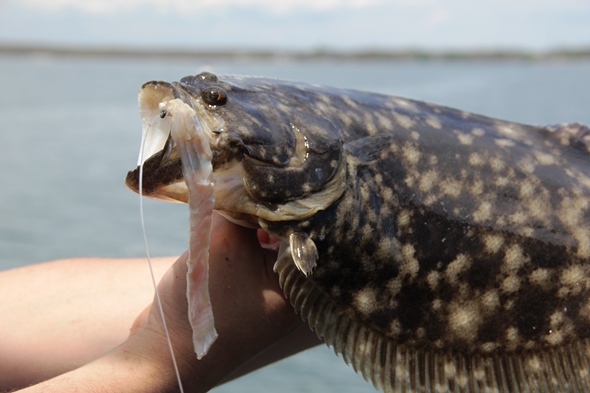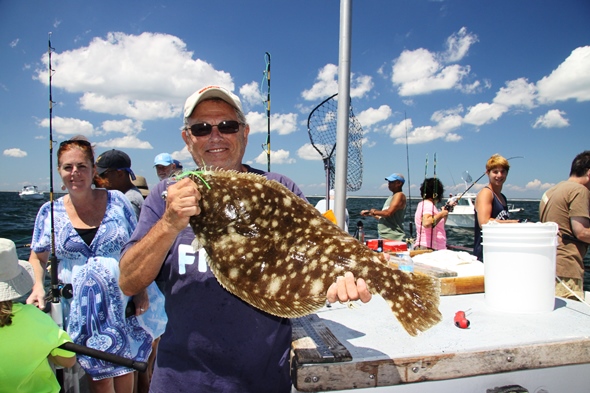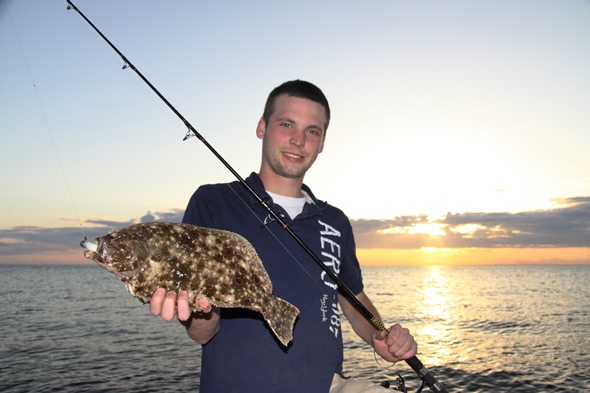FISHING: NEW FLUKE REGS? NOT SO FAST!

Keeper fluke love strip baits. Long, thin slices of sea robin, porgy, bluefish and legal fluke are favorite choices.
As was widely reported last week, the Atlantic States Marine Fisheries Commission (ASMFC) on February 4, 2014 passed a proposal to manage fluke catches in NY, NJ and CT as a single region under a combined quota. In the amendment, an example of how the fishery might be managed was provided using an 18” minimum size limit, four fish creel limit and a 128-day season for all three states.
“That was the example being considered at the time of approval,” said Capt. Tony DiLernia, New York’s representative to the Mid-Atlantic Fisheries Management Council, “but the new regional management ruling only guarantees all three states will share the same minimum size limit, bag limit and number of days in the open season. The specifics of the regulations are still subject to final approval.”
In other words, the new limits have yet to be adopted which means that New York’s 2013 fluke regulations remain in effect for now.
According to NYS-DEC spokeswoman Lori Severino, the size, bag and season restrictions will be finalized by a working group of biologists from the three states, using the latest data available. At that point, the states still need to go through their individual rule-making processes before the new rules actually take effect.
“New York,” said Severino, “will announce its rules for 2014 when they are adopted, likely by emergency rule making, before the fishing season begins. The regulations must reflect the fishery management plan but the details will wait for the outcomes of the workgroup and regulatory process.”
The ASMFC ruling covers only the 2014 season. Next year, following an evaluation of this year’s results, the ASMFC will determine whether or not to continue this regional management approach.

No matter the limits, anglers are free to release any fluke they want. This 7.5-pound doormat was weighted on a digital scale aboard the Shinnecock Star and was then released. The proud angler won the pool and still took home a limit of smaller fish for the table. Releasing trophies may help preserve the top end of the genetic pool.
Behind The Scenes At ASMFC
While it’s easy to give credit to the top politicians who spearheaded the campaign for fluke fairness, there were plenty of others working hard in the trenches and behind the scenes that also deserve a tip of the hat.
It’s been well documented that Governor Andrew Cuomo made the feds aware NY would sue if it did not get a fair share of the fluke quota going forward, and that Senator Charles Schumer introduced the Fluke Fairness Act to Congress which threatened legislation to resolve the issue. What you may not know is that Jim Gilmore, Bureau Chief of the Marine Resources Bureau for New York State DEC, coordinated DEC efforts, called the other state directors, and made an excellent presentation at the ASMFC meeting.
DiLernia initiated the science study that showed the fluke population is shifting north and putting more fish in New York waters, worked with both the Cuomo and Schumer staffs, called head-boat captain’s in other states, lobbied fellow council members, and presented an analysis to show how continued state-by-state process was illegal because it violated national standards. He passed along praise for the work of George LaPoint, the former ASMFC Chairman who NYS DEC hired as a consultant to work with DEC staffer John Maniscalco, calling their work “instrumental in pushing this legislation forward.”
“Maniscalco,” added DiLernia, “is a DEC fisheries biologist with a brilliant mind who developed the math formulas used to explain how the regional process would work.”
There are many others, of course, who deserve a pat on the back from New York’s recreational fishing community for pushing to establish regional fluke management. Suffice to say that all their hard work, plus new data and new math formulas that helped in interpreting the latest information, was enough to finally get the job done.
Was NJ Ripped-Off?
I spoke by phone with Tom Fote, a New Jersey representative on the ASMFC, on Tuesday, February 11, about New Jersey’s feelings on regional fluke management. Having had a few days to think about the new ruling, I thought he might offer a measured response. That wasn’t the case as he was clear in his feelings and sure where he wanted to point the proverbial finger. Highlights of that conversation included the following comments from Fote:
- “What’s really upsetting is that nobody in New Jersey wanted regionalization. In fact, at the public hearings, every state came out against the idea except for New York. So it’s a tough grind in New Jersey and our anglers are upset.”
- “I don’t blame the commissioners from New York. They were doing what they could to get the best results for their state – even if that meant going around the system and stealing fish from New Jersey. I can understand that.”
- “What I cannot understand is that the Regional Administrator for the Greater Atlantic Regional Fishery Office, John Bullard, came into an ASMFC meeting and basically favored one state over another as far as allocation. I found that to be totally unbelievable. He should have worn a T-shirt that said “I love New York but I screwed New Jersey,” because that’s exactly what he did.”
- “I’ve been coming to these meetings since 1982 and regional directors – as bad or as good as they were – have never got in the middle of an allocation battle. John Bullard came into the meeting, got the last word, and carried the day by convincing the ASFMC representatives from the US Fish and Wildlife Service and the National Marine Fisheries Service to vote for regionalization. Otherwise we had the votes to stay status quo.”
- “When we talk regionalization, we are supposed to be talking about a partnership to help two states work out details together. What happened here is that a couple of states ganged-up on New Jersey. My congressman and senators are upset over this, and there will be fallout…”
As things turned out, Massachusetts, Virginia and Rhode Island voted with New Jersey against regional management of the fluke quota. Fote said “that’s because they realized this regionalization proposal was unfair.” He also stated, in an interview by Richard Degener, staff writer for The Press of Atlantic City, that Delaware “threw New Jersey under the bus” when it voted for regionalization. Further into Degener’s interview, he added that “it sets a bad precedent where they basically take fish from one state and give it to another, because New York has been crying for six years.”
Even from a New York perspective, New Jersey does have at least one legitimate beef on this vote: The region including Delaware, Maryland and Virginia is projected to get a 16-inch minimum size limit. This would lead to two legal sizes on Delaware Bay – the same basic problem that New York argued needed to be resolved for border waters with New Jersey. Numerous Jersey party and charter boats, as well as private boaters from Cape May to Cumberland county, fish Delaware Bay for fluke.
“Delaware should have been included in the region with New Jersey,” said Fote.
“In the end,” he continued, “we got screwed by the regional director, John Bullard, and there’s going to be a big problem next year if this whole region goes over quota.”

With regional management now approved for fluke, New York shore anglers are hoping a smaller size limit will provide a reasonable shot at catching a keeper.
Voice From Across The Sound…
While the idea of regional management may be tough for some New Jersey anglers to swallow, there has been little overt push-back from recreational fishermen in the Nutmeg State.
“Generally, I think, it’s good idea,” a said Dave Simpson, Director of Marine Fisheries for the Connecticut Department of Energy and Environmental Protection (DEEP). “A lot of our anglers have for a long time asked that we work to have similar or identical management measures to those of our neighbors. We’ve achieved that for our biggest neighbor, New York, at least for the 2014 season. I think an 18-inch size limit, which seems likely at this point, is reasonable.
“Unfortunately, this ruling also creates a greater disparity with our neighbor in Rhode Island. It’s likely they’ll be able to drop their minimum size to 17 inches and they’ll probably continue to have a more generous bag limit than Connecticut anglers.”
So for Connecticut, as in New Jersey, the new ruling shifts the problem of having two different size limits for fluke off the New York border and to another part of the state. This could have been prevented by brining Rhode Island into the region with NJ, NY and CT, which was one of the options considered by the ASMFC.
“I was very disappointed that the regional administrator [for the Greater Atlantic Regional Fishery Office, John Bullard] made the motion [to keep RI out of this zone,] and that he made it so strongly, “ said Simpson. “Next year, we’ll have to start working again to achieve more consistent regulations for Block Island Sound.”
After talking to anglers and representatives from both NJ and CT, one thing is clear. The fluke regulations for all three states will be identical in 2014, but the fluke wars are far from over.
John Bullard Responds…
On Tuesday, February 11, I spoke with John Bullard, Regional Administrator for the Greater Atlantic Regional Fishery Office and asked for a response to some of the comments above. He wasn’t at all surprised that he had received mixed reviews:
“That simply goes with the job,” he stated, “almost any vote in my position is going to tick somebody off.”
Bullard was clear in his response, stressing that the council needs to react to fish stocks that are on the move while taking into account that outdated data may not reflect current trends. Excerpts of our conversation, which also covered the specific accusation that he took sides in a quota battle when he voted in favor of regional fluke management at the ASMFC meeting, appear below:
- “I don’t see it that way [taking sides in a quota battle.] The center of the fluke stock, whether due to climate change or because it’s simply expanding, has moved significantly north. With the allocations given to each state based on science from 1998, something had to be done. I think that a status quo of conservation equivalency based on 1998 numbers is unacceptable.”
- “I supported a regional management approach because summer flounder isn’t the only stock that is moving. All stocks are moving because the temperatures are warming. The stocks are not static. We [fisheries managers and council members] have to find ways to deal with stocks that are on the move but the problem needs to be solved where it’s supposed to be solved – in the Mid-Atlantic Council and the ASMFC – not on the Senate floor or in the courts.”
- “I saw this regional management ruling as an attempt to deal with something that we will increasingly need to address – fish stocks on the move. This is not an allocation fight; it is regional management that has allocation implications.”
Use the LIKE button below to get notifications about new articles in your Facebook news feed!



